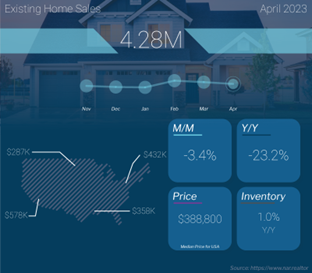
Existing Home Sales fell 3.4% from March to April to a 4.28 million unit annualized pace, per the National Association of Realtors (NAR). Sales were also 23.2% lower than they were in April of last year. This report measures closings on existing homes, which represent around 90% of the market, making it a critical gauge for taking the pulse of the housing sector.
What’s the bottom line? Tight supply is the key reason for the decline in sales around the country. While total housing inventory increased 7.2% from March to 1.04 million homes available at the end of April, it remains well below normal with just 2.9 months’ supply available at the current sales pace.
In addition, multiple data points suggest that demand remains strong. Homes stayed on the market on average for 22 days, down sharply from 29 days in March. Plus, 73% of homes sold in April were on the market for less than a month, which is up from 65% and shows homes are selling quickly when they’re priced correctly. Meanwhile, investors accounted for 17% of transactions last month, making up roughly one out of every six deals. Clearly investors are seeing the opportunity in housing right now.
Also of note, the median existing-home price fell 1.7% to $388,800 from a year earlier. However, this is not the same as a decline in home prices as some media reports implied. The median home price simply means half the homes sold were above that price and half were below it, and this figure can be skewed by the mix of sales among lower-priced and higher-priced homes. Actual appreciation numbers are higher, not lower, on a year-over-year basis and are showing acceleration according to key reports from Case-Shiller, CoreLogic and the Federal Housing Finance Agency.